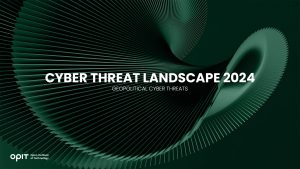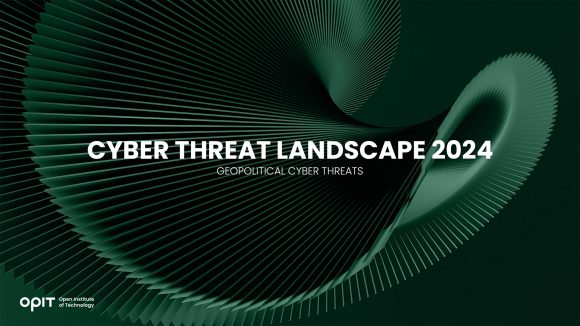

There are currently few things that worry CEOs worldwide as much as geopolitics. Cybersecurity is undoubtedly one of them. But what happens when you combine geopolitical conflicts and cyber threats?
Geopolitical cyber threats, that’s what.
This lethal combination threatens to disrupt economies, destabilize governments, and shatter global stability. That’s why it must be met with an ironclad cybersecurity strategy.
But what does that strategy entail?
That’s for Tom Vazdar and Venicia Solomons to answer. Tom is the chair of the Master’s Degree in Enterprise Cybersecurity program at the Open Institute of Technology (OPIT). Venicia is a seasoned cybersecurity architect and advocate who has rightfully earned the nickname “the Cyber Queen.”
Here’s what these two esteemed cyber professionals have to say about geopolitical cyber threats in their highly informative master class titled “Cyber Threat Landscape 2024: Navigating New Risks.”
What Are Geopolitical Cyber Threats?
Geopolitical threats refer to cyberattacks (or campaigns) driven by political motives. These attacks are often conducted by state-sponsored actors and have a specific strategic goal in mind.
For instance, Iran-backed hackers have recently been targeting U.S. water systems, aiming to disrupt Israeli-made equipment globally. This example also perfectly illustrates the targets of geopolitical cyberattacks – critical infrastructure, government systems, military networks, and other relevant entities.
But don’t jump to conclusions – the private sector isn’t immune to such attacks.
Cybercriminals have also targeted private companies to steal intellectual property, disrupt operations, or extort money. However, what differentiates these attacks from other cyberattacks is the motivation behind them.
Whether it’s through espionage, sabotage, or disinformation, geopolitical cyber threats always aim to achieve a political or strategic advantage for the attacker.
How Do State-Sponsored Cyber Threats Differ From Other Cyberattacks?
In their master class, Tom and Venicia specifically focus on state-sponsored cyber threats, even though they aren’t the only type of geopolitical cyber threats. Why? Because they’re the most advanced and sophisticated cyber threats.
As Venicia puts it, state-sponsored cyberattacks involve “specialist hacking techniques,” “stealthy behavior,” and “stealthy execution.” That’s why the consequences of these attacks are often only seen after significant damage has been done.
This leads us to another distinctive characteristic of state-sponsored cyberattacks – they typically involve long-term execution.
You see, other forms of cyberattacks usually want to reach their goal as soon as possible. For instance, a ransomware attack will infiltrate your system, and the hacker will ask for ransom straight away.
A state-sponsored cyberattack, on the other hand, usually plays the long game. That’s why they’re considered an advanced persistent threat (APT). Remaining undetected for a long time allows these threats to collect lots of critical data and perform long-term espionage.
Tom adds that the goal of these cyberattacks is another important distinction. As mentioned, they usually have a strategic goal in mind. “Regular” cyber threats, in contrast, typically only aim for financial profit.
Why Is Geopolitical Cybersecurity Important?
For the most part, traditional warfare was limited to three battlefields – the land, the air, and the sea. However, as Tom points out, two vital battlefields have joined the fray – space and cyberspace.
Sure, threats in cyberspace aren’t overtly visible like those on land, air, or sea. However, they can be just as devastating, if not more so – especially if they’re geopolitical cyber threats.
Here’s how Tom and Venicia break down the importance of geopolitical cybersecurity.
Protecting Against Espionage
As mentioned, espionage is one of the leading types of geopolitical cyberattacks. Since espionage aims to collect as much valuable information as possible, these attacks are typically highly refined, which allows them to remain undiscovered for months on end.
Venicia points out that the recent geopolitical tensions have led to increased cyber espionage. That’s what makes solid geopolitical cybersecurity more important than ever. Let one intruder into your network, and you’re essentially giving away all your classified information (past, present, and future).
Avoiding Manipulation
2024 is an election year. This means that “influence operations, disinformation operations, [and] deep fake operations” will run more rampant than ever, as Tom warns. Ultimately, these operations aim to shape public opinion and undermine trust in democratic institutions. These outcomes are never desirable, let alone during such a crucial time.
That’s where cybersecurity comes into play.
These measures help secure digital platforms, detect (and remove) false information, and (in this specific scenario) safeguard electoral systems.
Protecting the Economy
As mentioned, geopolitical cyberattacks aren’t typically done for financial gain. However, they can still cause massive financial losses. How? By targeting “public organizations and private entities that make a large contribution to a country’s economy,” as Venicia explains.
And a world that’s still reeling from the effects the COVID-19 pandemic had on the global economy can’t possibly handle another major disruption. That’s why any similar threat should never be taken lightly.
How to Combat Geopolitical Cyber Threats
Now that you know why geopolitical cyber threats must be combatted, let’s discuss how this can be done.
Keep All Aspects in Mind
There are numerous factors that go into protecting against geopolitical cyber threats. But for this protection to actually work, all these factors must be considered when devising a defense strategy.
For starters, this means protecting all critical infrastructure sectors. Tom lists just some of them –financial services, healthcare and public health, and transportation systems. However, one thing applies to all critical infrastructure sectors – they aren’t “independent islands,” as Tom puts it.
They’re all part of a larger ecosystem.
Each sector can only be protected if there’s a holistic approach to cybersecurity, one that considers interdependencies between sectors and the potential cascading effects of cyber disruptions. This way, in case of a cyberattack, every sector can provide support and respond effectively to minimize the impact.
Foster Collaboration
The collaborative approach shouldn’t only apply to critical infrastructure sectors. All stakeholders, including government agencies, cybersecurity experts, and the private sector, must work together to address geopolitical threats effectively.
This collaboration can take many forms.
However, Tom highlights the three most important ones on the global level – sharing intelligence, developing international norms and agreements, and establishing cybersecurity alliances.
Our experts list some of the most useful alliances and resources in this regard:
- The No More Ransom Project helps organizations combat ransomware attacks by providing decryption keys, thus returning their vital information.
- Public-Private Partnerships (PPPs) worldwide allow for sharing cyber threat intelligence among industry partners to improve defenses collectively.
- The Budapest Convention on Cybercrime sets out international standards for combating cybercrime, promoting cooperation among countries to tackle cyber threats effectively.
Focus on Critical Infrastructure
By now, one thing’s clear – protecting critical infrastructure against geopolitical cyber threats is paramount.
According to Tom, collaboration plays a key role here as well. In his words, “The only way to protect [critical infrastructure] is that collaborative effort between government and the private sector because they cannot go without each other; they have to work together.”
Implement a Robust Cybersecurity Framework
A comprehensive and collaborative approach to combating geopolitical threats is just the preamble. The implementation of a robust cybersecurity framework is where the actual protection starts. Of course, these systems should be based on the intelligence collected through collaboration and education.
However, the system itself is just as important. After all, protecting critical infrastructure and other elements of similar importance requires more than just traditional anti-virus software!
According to Tom, a comprehensive cybersecurity framework will comprise four elements – threat detection, response tools, regular security assessments, and training. The specifics will vary by organization, and every relevant employee should be familiar with them.
Tom also emphasizes the importance of adopting a multi-layer approach to cybersecurity defenses. This way, even if one layer is breached, others will provide protection and prevent a total collapse of the system.
Stay Vigilant
Organizations should always be on the lookout for an uptick in suspicious activities, especially during times of geopolitical conflicts. This vigilance includes monitoring network traffic for anomalies, conducting regular security audits, and staying on top of the latest cyber threats and—let’s face it—the latest geopolitical conflicts.
Train Your Employees
The importance of thorough cybersecurity education can’t be understated. After all, employees are usually the first line of defense against cyber threats. So, they should be trained to handle the information system properly within the organization. They should know what to do and what not to do before, during, and after a geopolitical cyberattack.
However, there’s another type of employee crucial for the strength of cybersecurity within an organization – cybersecurity professionals themselves.
These individuals must be on top of their game at all times. One way to ensure this is to only hire professionals with ample experience and education. For instance, completing a renowned Master’s program like OPIT’s Enterprise Cybersecurity should be a huge green flag for any employer. It signals a strong commitment to cybersecurity excellence and a deep understanding of the latest trends and techniques in the field.
Invest in the education and professional development of your employees, and you stand a chance against the ever-evolving landscape of cyber threats, geopolitical and beyond.
Related posts

Life is unpredictable. While many of us have specific hopes and expectations of how our futures will turn out, things don’t always go as expected. There are many variables and unexpected incidents that can interfere and force you to alter your plans, and this is particularly true when it comes to education.
For instance, you might have had plans to study a specific subject, but had to deviate from those plans due to unforeseen circumstances. Or you may have had to enter the workforce in an occupation different from the one you sought in an effort to earn an income, a move that may not provide you with the time or opportunity to achieve your desired educational aims.
In short, every individual’s career pathway is different, and very few go exactly as we expect from the outset. Fortunately, even if you experience a few false starts or sudden twists in your pathway, there are always options available to help you get back on track.
The Unpredictable Nature of Education
In theory, the educational process seems simple. You select a course of study that interests you from the vast array of subjects and prospective professions, select the appropriate classes, acquire the knowledge and skills you need to succeed, and then embark on your profession.
In reality, however, as many people know from firsthand experience, the road to education is often far from straightforward. Here are just some of the many challenges that can take your educational path in a completely different direction:
- Life’s Curveballs: As touched on in the introduction, life is impossible to predict. Financial hardships, health issues, and family emergencies are just some of the unfortunate occurrences that might derail even the most perfectly planned educational regime.
- Changing Interests: People’s desires and preferences don’t necessarily stay the same throughout their entire lives. As you grow, learn, and have new experiences, your interests may change, and so, too, may your educational objectives.
- Pressure and Burnout: Some academic paths are particularly challenging, demanding intense levels of study and hard work. This can sometimes prove too much to bear, even for the most resilient students.
- Failures and Setbacks: Conventional education largely builds around tests and examinations, requiring students to demonstrate their competencies repeatedly. It’s a system that doesn’t suit everyone, and test failures can lead to setbacks and delays.
- Inequality: People can be born with very different privileges and levels of access to education. Those in certain parts of the world may find it much more challenging to complete their education path for financial, cultural, or even political reasons.
- Late Bloomers: People develop at different paces. Some may struggle educationally early on in their lives, forcing them to make certain concessions or sacrifices related to their studies, only to find their feet later in life once they’ve entered the world of work.
Whether you’re a late bloomer, have had your educational aspirations delayed by personal problems, desire to learn new skills and try something different, or want to begin a fresh chapter in your professional life, the Open Institute of Technology (OPIT) may be able to help.
Introducing OPIT
OPIT is an online teaching platform, making high-level technological educational programs accessible to all, no matter their age or background. Offering education in fields like computer science, artificial intelligence, and digital business, OPIT provides a curated collection of degrees. In addition, they offer classes taught by world-leading tutors imparting the wisdom and skills students need to achieve their goals and become the tech leaders of tomorrow.
Meanwhile, for those who have had somewhat tumultuous or unpredictable educational paths, OPIT offers the perfect course corrector: the OPIT Foundation Year.
The OPIT Foundation Year
OPIT’s Foundation Year is a Pre-Tertiary Certificate in Information Technology, fully aligned with MQF/EQF Level 4 standards and valued at 60 ECTS credits. Lasting just one year, this program essentially serves as a comprehensive yet accessible springboard towards higher-level education, creating a path towards degrees and careers in dynamic, flexible fields, like computer science and digital business.
Like other OPIT programs, the Foundation Year is delivered entirely online via the OPIT Virtual Learning Environment. Combining live lectures, asynchronous content, and interactive assessments, students enjoy diverse and dynamic study experiences, acquiring core skills like academic writing, mathematics, and computer literacy, and building a bedrock of knowledge and confidence before taking their next steps.
Who Is the Foundation Program For?
The Foundation Program is designed to provide a solid base upon which to build the technological education many students need. It’s the perfect choice for those who are eager and ambitious to enter professions in AI, data science, and computing, but don’t feel that they have the necessary core skills and knowledge needed to dive straight into a degree.
Entry requirements are relatively relaxed in order to allow as many students as possible to enjoy the benefits of this program. With that said, applicants should ideally hold an MQF/EQF Level 3 or equivalent qualification, with the intention of pursuing a bachelor’s degree. A minimum of B2 level of English proficiency is also required, as this is the working and studying language of the institution.
What the Foundation Year Provides
Perhaps you’ve recently graduated, are considering a career change, or finally have the opportunity to return to education after initial delays or unexpected disruptions to your original plans. Either way, the Foundation Year can help you enjoy:
- Greater Self-Confidence: Foundation Year graduates gain the fundamental skills they need to enter degree programs with much more self-belief and assuredness.
- Superior Tech Knowledge: Lasting two terms, this course explores mathematics, academic reading and writing, and provides an introduction to computer hardware and software.
- Foundational Mathematics: Mathematics literacy forms a large part of the study focus for the Foundation Year, helping students feel more comfortable with numbers and formulas.
- Flexible Learning: Unlike more rigid, conventional education environments, OPIT gives you the freedom and flexibility to study at a pace that suits you best, all from the comfort of home.
- Global Community: OPIT is an international institution, with staff and students from all around the world eager to share knowledge, exchange ideas, and help one another.
Take Your Next Steps to Success With the OPIT Foundation Year
If you’re curious about a career in technology or have always wanted to work with AI, data, and computers, but struggled to find the time and opportunities you need to acquire relevant skills and knowledge, the Foundation Program was made for people like you.
It’s the ideal entry point into the exciting world of online education, and the perfect first step towards a prestigious degree from an innovative and increasingly successful institution. Download the brochure to learn more about it, or start your online application, today.

Students today have a broader range of fields of study to choose from than ever before, but with the world becoming increasingly technological and computers increasing in influence and importance, pursuing a career in computer science often proves a smart, strategic choice.
There are numerous benefits and career paths associated with studying and working in computer science, and we’ll be listing just a few of them in this guide.
High Average Salaries
With the rising cost of living in many parts of the world, it’s unsurprising that many students are thinking several decades ahead to determine what level of starting salaries they could obtain in different career fields.
Many are also seeking professions that offer the opportunity for growth and the ability to advance up the ranks over time, thus increasing their salary and their quality of life in the process.
If a strong, stable salary with the opportunity for improved income is one of your top career priorities, computer science should be at or near the top of your list of prospective careers.
According to recent data, computer scientists earn an average of over €65,000 per year, with certain jobs, like IT project leader and data scientist, paying ever higher. Starting salaries are strong, too, with graduates earning anywhere from €46,000 to €60,000, depending on their chosen profession and level of qualifications.
There are similarly high average salaries reported around the world in computer science and related fields such as data science and AI/ML engineering. These numbers are projected to increase in the years to come, pointing to computer science as a way for graduates to get off to the best financial start of any career.
Unrivaled Flexibility
A common problem with some subjects and courses is that they only provide graduates with a narrow set of skills and a similarly narrow range of potential professions to which they can apply those skills.
That’s not the case with computer science. Graduates in this field can enjoy instant access to a remarkably diverse array of career opportunities, with even newer opportunities being created all the time as technology evolves and innovations emerge.
A few of the many industries and roles you might choose to enter in the field of computer science include:
- Healthcare: As a software developer, data analyst, or cybersecurity expert
- Finance: As a fintech engineer, blockchain developer, or security analyst
- Media: As a graphics programmer, AI developer, or game developer
- Education: As an analyst, software developer, or machine learning engineer
Guaranteed Opportunities
Some career paths are more limited than others, with relatively low numbers of opportunities, recurring risks of job loss, or difficulty obtaining employment in the first place.
Again, with computer science, this simply isn’t the case. At a time when 75% of companies plan to embrace AI and other technologies by 2027, and businesses of all sizes and industries are now relying on computers more than ever before, computer science graduates can enjoy almost unbeatable job security.
Opportunities will continue to grow for people with good computing knowledge, whether that be in the obvious fields like software and web development, engineering, and AI development, or more niche sectors.
With so many options, you’re effectively guaranteed a long, rewarding career if you put in the necessary time and effort needed to establish a strong foundation of computing skills.
Rapidly Expanding and Evolving Industries
It’s no secret that the world of technology is a dynamic and fast-moving one. In the past 20 years alone, we’ve seen the proliferation of the internet, the rapid advancement of smartphones and wearable devices, the emergence of AI, and so much more.
In the years ahead, engineers and developers will continue to explore the boundaries of modern technology’s powers and potential, driving new innovations and improvements and opening more exciting job opportunities for those already established and experienced in this field.
Getting into computer science now could therefore provide a solid foundation for a career filled with excitement as you uncover and explore new ways of working with computers in fields as diverse as healthcare, finance, education, entertainment, manufacturing, logistics, and beyond.
Start Your Computer Science Career at OPIT
We’ve discussed some of the many benefits associated with careers in computer science, from the high starting salaries to the rapidly growing array of job options available to graduates. By now, you may be eager to follow this particular career path and take advantage of the wealth of opportunities.
If you’re wondering how to start, the Open Institute of Technology (OPIT) may hold the answers you need. As an exclusively online learning platform, specializing in computer science and digital business, and staffed by some of the world’s leading tech experts, OPIT is producing the tech leaders of tomorrow.
Some of the many advantages of learning with OPIT include:
- Accessible and flexible online education that matches your learning style and schedule
- Heavy focus on real-world applications of the skills you acquire
- An international community of like-minded students from around the globe
- A top team of tutors and lecturers from varying fields and industries
- Progressive assessment of skills and understanding – not constant exams
OPIT offers a small, curated selection of courses for those seeking to gain the technological skills and knowledge to succeed in their chosen areas of expertise. That includes a BSc (Hons) in Computer Science – a six-term program, worth 180 ECTS credits.
Numerous IT industry leaders and experts helped develop this fully accredited undergraduate degree, which is online and accessible to all. Like other OPIT courses, it offers a flexible learning program, with progressive assessments, fast-track options, and the opportunity to be part of a growing community of learners and tutors.
If the benefits of doing a career in computer science interest you, download the OPIT BSc in Computer Science brochure or fill out an online application today and take your first step toward a rewarding and fulfilling profession.
Have questions?
Visit our FAQ page or get in touch with us!
Write us at +39 335 576 0263
Get in touch at hello@opit.com
Talk to one of our Study Advisors
We are international
We can speak in:


